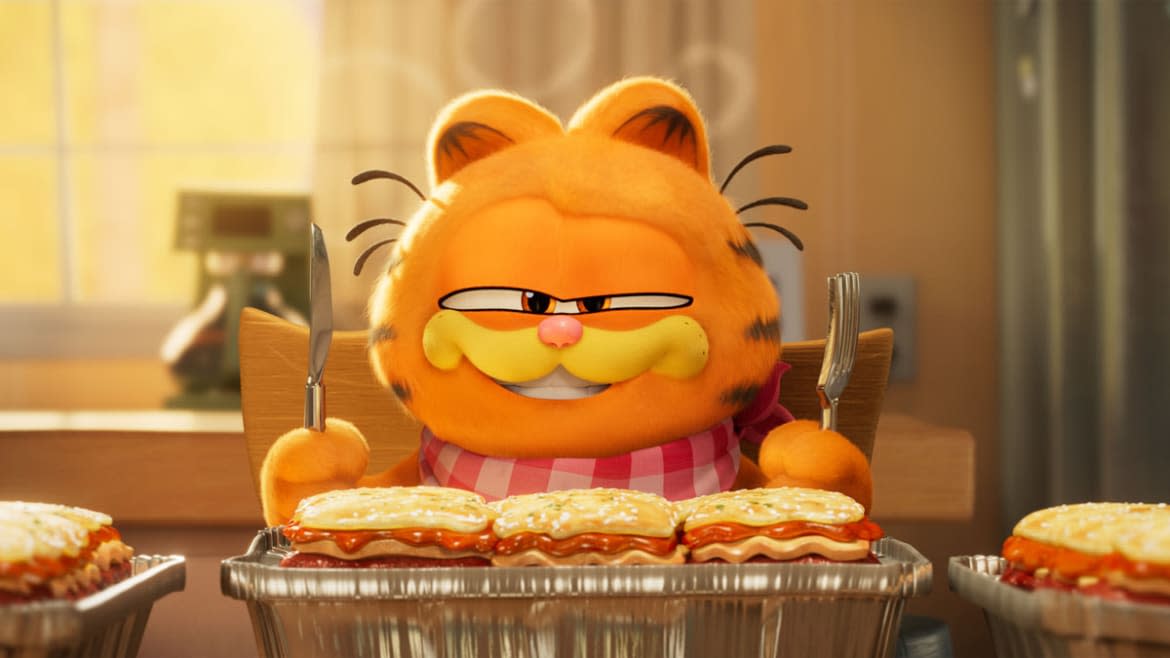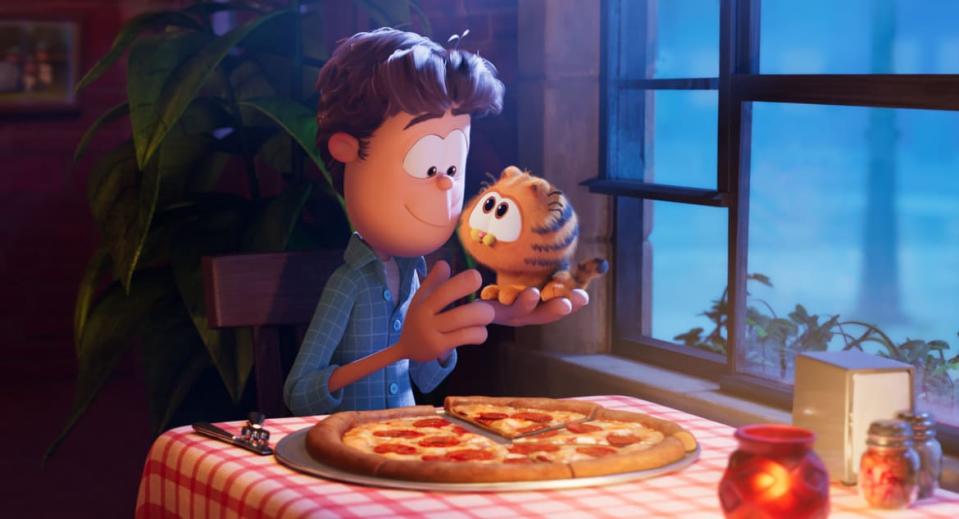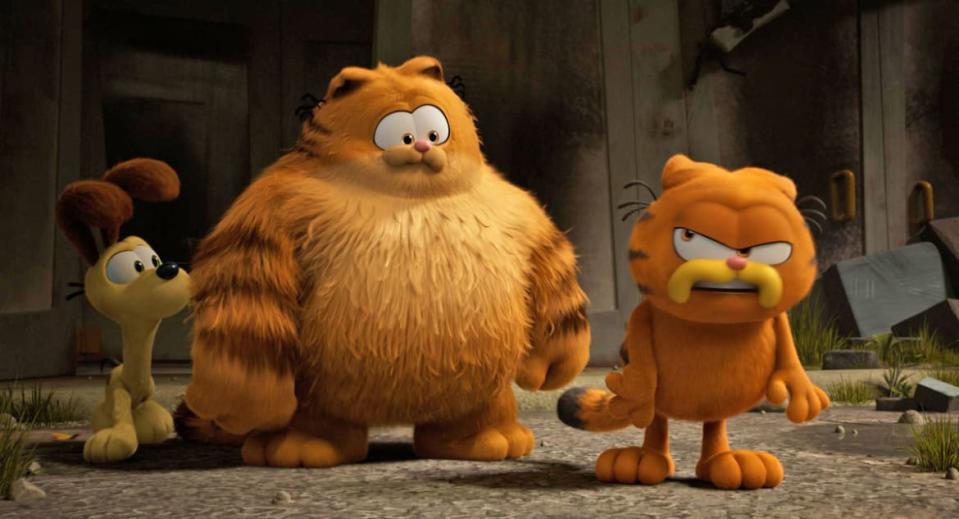‘The Garfield Movie’ Wastes His Ninth Life

- Oops!Something went wrong.Please try again later.
Who the hell gave Garfield a smartphone? Granted, the world has changed significantly in the 46 years since Jim Davis’ comic strip about the adorably misanthropic orange tabby cat was first published. But Garfield’s tastes have remained constant. The portly fella hates Mondays with almost the same intensity as he loves lasagna—and don’t even get him started on Odie, the yapping canine he deigns to share Jon Arbuckle’s suburban palace with. These are characteristics that anyone with even a vague familiarity with Garfield knows, but they’re defining traits that The Garfield Movie (in theaters May 24) is barely concerned with.
Instead, Garfield’s first cinematic outing since 2006’s Garfield: A Tale of Two Kitties—remarkably, this is the cat’s first entirely animated feature film—molds Garfield into the any-cat. With a phone in his paws, Garfield has access to everything he loves at the tap of a claw, and the ability to avoid most things he detests. While this could be a clever way to update Garfield’s antics for the modern day—inserting new obstacles in the long road back to bed—his newfound love of tech lazily strips Garfield of his most integral quality: cynicism. The Garfield Movie fundamentally misunderstands the charm of Garfield. A phone wouldn’t solve all of this cat’s problems; it would exacerbate them. Cynicism is the flavor of the moment, something that everyone is deeply entrenched in thanks to our constant proximity to screens. Yet, for Garfield—the most pessimistic feline in the world—the smartphone somehow makes everything better.
It’s no surprise, then, that the film’s storyline is as conventional and vacant of character as its vision of Garfield is. In this new adventure, Garfield (voiced by Chris Pratt, who doubles down on criticisms of his Super Mario Bros. Movie accent with some of the most robotic voice work in recent memory) finds the rhythm of his ideal life jeopardized by the return of his father, the scrounging outdoor cat Vic (Samuel L. Jackson). Though their reunion makes for a steady emotional undercurrent, Garfield and Vic’s ensuing adventure is so safe and systematic that the movie’s titular character is almost entirely swallowed up by it; plop any other iconic cartoon into this movie, and you’d still have a decent excursion. While its animation is pleasant enough and the slapstick humor is milked for all its worth, The Garfield Movie lacks the relatable attributes we crave from Garfield, propping up a decades-old IP for a feature-length commercial disguised as a movie.

Jon with baby Garfield.
The torture starts in the movie’s opening frames, which see Garfield ordering a heaping helping of family-size lasagna and other Italian treats on the screen of his phone. He has the option to receive his order in one hour, 30 minutes, or immediately. Of course, Garfield selects the third option—because not even house cats are exempt from succumbing to the culture of instant gratification—and in no time, Garfield’s order has arrived. “It might be nice to have something in the salad family,” Garfield’s narration tells us, as he gobbles up some jalapeno breadstick balls. This one line offers a brief glimmer of hope: Maybe, just maybe, a phone-addicted Garfield can still be the familiar cat we know and love. But that hope withers away the moment Garfield shoves the leftovers into Jon’s fridge, next to takeout boxes conspicuously emblazoned with the Olive Garden logo.
This prologue prepares audiences for a film where advertisements are more thoughtfully written into the script than its star character’s identifying qualities. A brief introduction catches up any young viewers on the Garfield lore, before tossing all of the lasagna and Monday talk out the window. This wouldn’t be so bad if the character retained some of his leaden misanthropy, but Pratt’s monotonous voice work can’t match Garfield’s distinct temperament. Both The Garfield Movie and its star voice actor are deeply confused about their own identity, and that confusion creates a discordant viewing experience not unlike chowing down on a spoiled batch of lasagna.
Part of what makes The Garfield Movie so perplexing is that its director and the rest of its voice cast, sans Pratt, seem to know exactly what movie they should be making. Jackson’s Vic is a lovable new addition to the Garfield canon. Vic is prickly, but beaming with paternal warmth as he tries to explain to his son where he’s been the last five years, since Jon found Garfield, abandoned, outside an Italian restaurant. (This flashback scene, beautifully animated down to the minute details of Garfield’s amber kitten fur, is one of the film’s saving graces.) Other new characters, like the wicked pussycat Jinx (Hannah Waddingham), who hatches a revenge plan against Vic, and Otto (Ving Rhames), a stoic bull who gets roped into Vic and Garfield’s mess, are voiced to perfection; each is laden with the kind of individuality this version of Garfield wishes he could have.
‘Furiosa’ Will Make Everyone Obsessed With Anya Taylor-Joy
When the movie’s plot gets going, it’s easy to lighten up a bit—even if it is a blatant ripoff of 2000’s Chicken Run. Jinx is determined to settle the score with Vic, who had allowed her to take the fall for a dairy robbery back in his crime days. In turn, Vic will have to finish carrying out the robbery, getting a quart of milk for each day Jinx was in the pound. Navigating the high-security dairy (doltishly named, simply, “Lactation Farms”) generates some briefly exciting, Mission: Impossible-level antics, a self-aware nod to Rhames’ casting. At a few points, I even caught myself wondering if I was the cynical one this time around, unwilling to bend to a cartoon cat who has every right to change his tabby stripes.
But just as fast as the action gets going, the story peters out again. The actual heist makes up around 10 minutes of the film, barely enough time for the delightfully nasty security guard Marge (Cecily Strong) to develop a plan of attack. And when things inevitably go awry, Garfield and his pals use—what else?—an app on their phone to translate kitten meows to human speech, trying to finagle a solution.
Although the film’s script, tackled by three different screenwriters, is relentlessly perplexed by its own existence and overloaded with photorealistic brand sponsorships, director Mark Dindal at least provides The Garfield Movie with a decent dose of flair, often in unexpected ways. A sequence in the middle of the film, which details Otto’s backstory, is a marvel of 2D, hand-drawn animation, reminiscent of a child’s storybook. It’s a nice touch, one that adds an essential layer of intention to a largely soulless film. But it also reminds viewers of just how much the personality-devoid CG art style of The Garfield Movie lacks. Davis made Garfield’s art compelling in something as small as a four-panel comic strip. The Garfield Movie can hardly manage that once in a 101-minute film.

Odie, Vic, and Garfield.
While The Garfield Movie isn’t exactly a death knell for this fat cat, it doesn’t instill much hope for his future. Surely there are ways to bring Garfield into the present without eliminating all of the things that made him so beloved in the first place. If enduring characters have to be saddled with smartphones and drones to modernize them for a new generation, they may as well be left in the past as fond memories. The world is bleak enough as it is without giving its most disenchanted cat access to the same technology that has already depersonalized our entire world. If we lose Garfield to the pull of the blue light, every day may as well be a Monday.
Get the Daily Beast's biggest scoops and scandals delivered right to your inbox. Sign up now.
Stay informed and gain unlimited access to the Daily Beast's unmatched reporting. Subscribe now.

